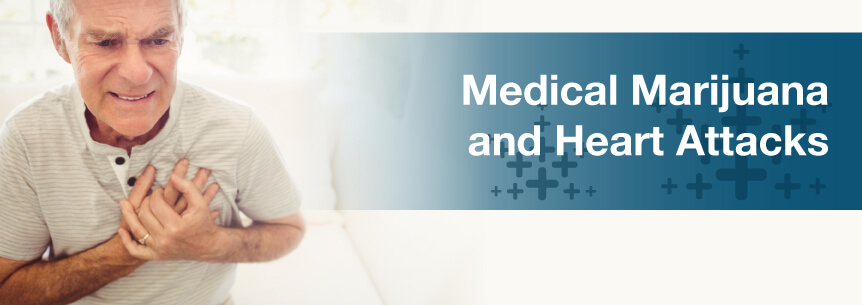
Someone in the U.S. has a heart attack every 40 seconds, according to the Centers for Disease Control and Prevention (CDC). While prevention is the best cure for a heart attack, knowing the signs and symptoms of a heart attack and what to do when experiencing them can save lives — perhaps even your own.
The muscles in your heart need oxygen. Heart attacks happen when a blockage occurs, slowing or preventing oxygen-rich blood from flowing into the heart, which often occurs because of plaque building up in your coronary arteries.
Heart attacks can be fatal, but taking prompt action and calling 9-1-1 when the first symptoms appear can dramatically increase survival rates.
Knowing the heart attack signs to look for can greatly improve your odds of surviving a heart attack or helping save the life of someone else who is experiencing one.
Look for these five major symptoms of a heart attack and call for emergency medical help right away.
Of course, these aren’t the only signs and symptoms of a heart attack. Plus, some heart attacks occur without any symptoms commonly associated with them. Do not dismiss the following symptoms, which may indicate a heart attack:
“Silent” heart attacks occur without any symptoms and are most common among people who have diabetes.
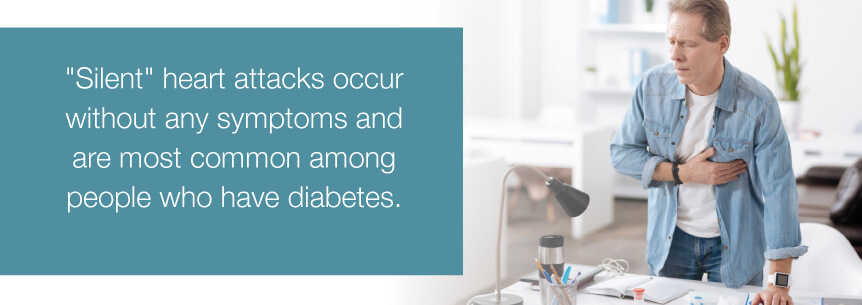
Go Red for Women, a campaign by the American Heart Association to raise awareness of heart attacks among women, interviewed Dr. Suzanne Steinbaum, director of the Heart and Vascular Institute at New York City’s Lenox Hill Hospital in New York City, about silent heart attack symptoms. She began by recommending women recognize the following symptoms as potential heart attack signs:
She went on to suggest more women follow their gut instincts, even in the absence of obvious heart attack symptoms, saying 90 percent of her female patients just knew it was their hearts — even though the symptoms weren’t consistent with the usual culprits.
Heart attacks happen when blockages occur preventing oxygen-rich blood from flowing into the heart. Coronary heart disease is the leading cause of heart attacks, and it occurs when plaque builds up in the arteries and slows the flow as a result of a disease called atherosclerosis.
The process typically takes years. Over time, the plaque hardens, eventually breaking off to create blood clots that potentially slow or completely block the flow of blood to your heart.
Heart attacks may also happen if a severe spasm occurs in the coronary artery, cutting off the supply of blood going into the heart. This method is not as common as coronary heart disease for causing heart attacks.
Probable causes of coronary artery spasms, according to the National Heart, Lung and Blood Institute, include:
A high-fat diet contributes greatly to heart attack risks, but other lifestyle choices, as well as genetics, play roles in defining your heart attack risk.
Some things increase your risk factors for heart attacks and warrant consideration, even if you aren’t experiencing “normal” heart attack symptoms. They include:
There are also non-lifestyle risk factors to consider, such as a family history of heart disease or heart attacks, age and preeclampsia. Preeclampsia is a condition occurring during pregnancy and has a strong link to lifelong increased risks for:
For causes you have no control over, fast action when heart attacks occur saves lives. Seconds matter. Call for help at the first signs or suspicions.
Acute coronary syndrome describes three types of coronary artery diseases associated with rupturing plaque inside your coronary artery.
While some heart attacks are more severe than others, there is no such thing as a good heart attack. Regardless of the severity, your likelihood of a lasting recovery improves greatly the faster you receive emergency medical attention.
As the U.S. Department of Health and Human Services reports, in the 1960s, deaths from heart attacks were not uncommon for people in their 50s and 60s. Had those rates continued into today, there would be 1.7 million more lives lost to heart attacks each year than the current numbers.
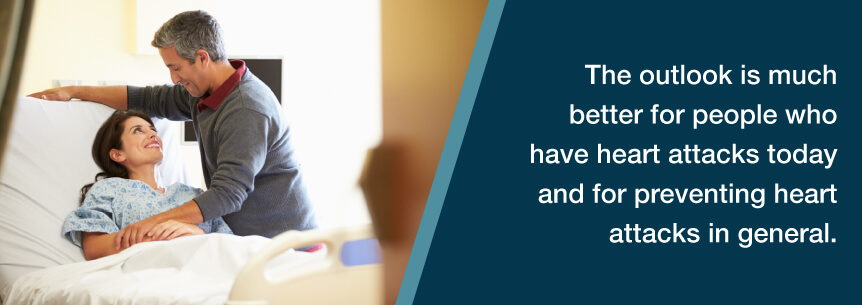
The outlook is much better for people who have heart attacks today and for preventing heart attacks in general. The following factors have played vital roles in these improved numbers related to cardiovascular disease:
The future looks brighter than ever as technology advances and awareness of heart disease and heart attack risk factors improve.
Heart attacks’ most significant risk factor is death. The risk increases with every minute delayed in getting medical attention once you begin to suspect a heart attack.
Beyond this, heart attacks damage the heart muscle. Each subsequent heart attack causes greater damage to the muscle and can lead to more serious heart conditions requiring more intense interventions.
Recovery from mild heart attacks can be quick, allowing you to return to normal routines within a few weeks of the event. Stronger heart attacks require lengthier physical recovery periods.
The emotional effects of heart attacks can be long-lasting and lead to depression as you face fears of your mortality and concerns that another heart attack is imminent.
Consider joining a patient support group — which most hospitals offer — to talk to other people who are coping with similar fears, concerns and adjustments after a heart attack for help, and talk openly with your family about how you feel during this stressful time.
The CDC offers some alarming and insightful heart attack statistics to consider if you suspect you’re having a heart attack.
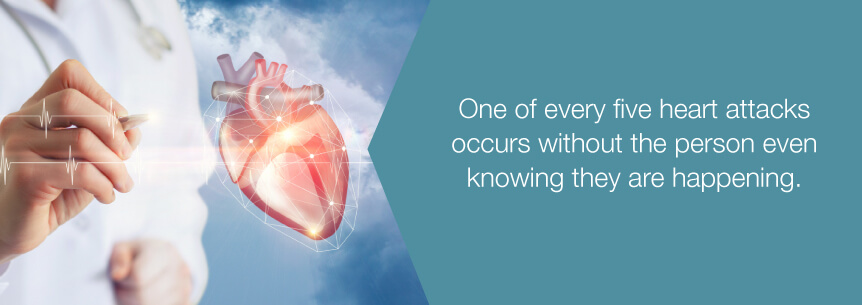
Today, more treatments than ever exist for heart attacks, and they vary according to the type and location of the cardiac event. According to the American Heart Association, some of the common treatments for heart attacks include:
These procedures are all in addition to various medications your doctor may prescribe to help your heart function at greater efficiency, despite the damage to the muscle the heart attack caused.
New developments are on the horizon for treating heart disease and heart attacks, including more than 200 medications currently in development to treat heart disease and stroke. New studies indicate great promise for using an anti-inflammatory drug, canakinumab, to lower heart attack risks and slow cancer progression.
While heart disease remains the No. 1 killer of men and women in the United States, the numbers are down substantially in the last 50 years. With improvements in awareness and new treatments on the horizon, perhaps we can stamp out this disease in the next 50. Until then, understand the signs and seek medical help immediately if you believe you’re having a heart attack.
The conclusions as to marijuana’s effects on heart attacks are unclear, with various studies and research revealing conflicting results. Experimental research has minimal credibility because of other confusing factors like measurement of use, genetic manipulation of cannabis strains and negative health behaviors like:
Therefore, the effects are unpredictable.
You may have heard using cannabis may lead to postural fluctuations in blood pressure in humans, which could be under suspicion for developing strokes and heart attacks. However, there aren’t any rigorous, conclusive studies to guide us about the herb, since it’s been illegal for many years.
There’s evidence suggesting marijuana may limit cell damage and provide neuroprotection and cardioprotection after ischemic occurrences like strokes and heart attacks. For instance, a study found THC at extremely low doses given to the patient two hours, 48 hours or three weeks consistently before a heart attack decreased the size of the blockage, thereby reducing heart damage.
A more recent study reviewing hospitalized patient records found those patients who recently used cannabis had a lower mortality rate. They also had a decreased risk of shock and intra-aortic balloon pump placement after having a heart attack. The findings of this study suggest using medical marijuana before having a heart attack could increase hospitalized patients’ survival rate.
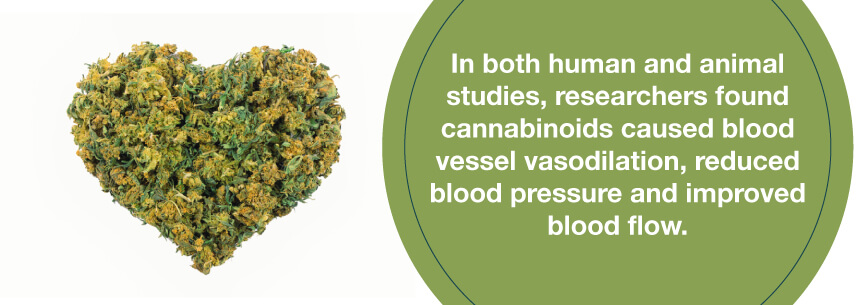
In both human and animal studies, researchers found cannabinoids caused blood vessel vasodilation, reduced blood pressure and improved blood flow.
Alexander Stokes, a research professor at University of Hawaii’s John A. Burns School of Medicine, believes some cannabis compounds can help treat heart failure by activating a particular receptor to boost the heart’s ability to pump blood, without eventually failing.
Another study conducted by researchers from Boston’s Harvard Medical School found cannabis use increases the risk of a heart attack in the first hour after use to five-fold the normal risk rate.
Researchers need to conduct additional studies to definitively determine the impact of cannabis on cardiovascular disease.
A 2013 study published in the British Journal of Pharmacology featured CBD’s potential related to the cardiovascular system. The CBD in marijuana for heart attacks in rodent models successfully decreased vascular tension, an ailment leading to needless blood vessel strain. Researchers also found CBD effective at protecting the arteries from glucose damage.
Findings published in this same review indicated cannabis for heart attacks decreases diabetes-related inflammation, which puts a substantial strain on your heart.
If you don’t treat hypertension, whether it’s with conventional treatments or medical pot, you could increase your risk of heart disease, stroke or other cardiovascular problems. Here are some helpful strains for hypertension.
The following strains may be beneficial for treating inflammation:
If you’ve already received your cannabis and heart attacks recommendation, you’re likely pondering which method is best for administering the treatment. Your cannabis doctor will factor in your condition and the results you’re seeking to recommend a method of administration and the proper dosage you should use. You may customize your medical weed use to meet your specific needs.
Some common delivery methods of medical cannabis for heart attacks include:
If you’ve just suffered a heart attack or have been struggling with heart disease and you’re looking for a less dangerous and more natural treatment option than prescription medications, marijuana and heart attacks treatment may be just what you’re looking for. You first need to check your state laws regarding medical pot and then consult with a cannabis doctor to discuss marijuana’s ability to help you and your heart. Search the Marijuana Doctors database for a medical weed doctor and find a cannabis dispensary today.
Find A Doctor Find A Dispensary